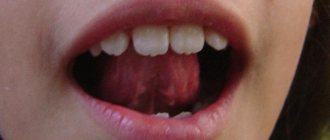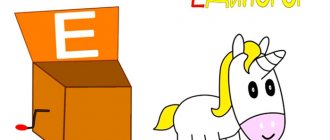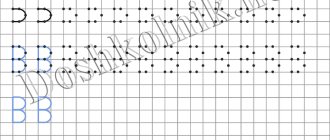Now you will learn about the letter and sound Y.
Listen to the words: reed , bylink , jump , lynx , soap .
These words have one common sound [s]. Let's get acquainted with this sound and its letter.
Let's say the word with y r. We can stretch out this sound by pronouncing the word s y r drawn out. The voice passes freely, does not encounter obstacles, this sound is a vowel. The peculiarity of the sound [s] is that it can only come after hard consonant sounds.
Examples:
- The sound [s] is located closer to the beginning of the word, after the hard consonant sounds [ts], [b], [v], [d], [l], [r], [m].
Ts of films, bull , exit , smoke , ski , fish , s
- The sound [s] in the middle of a word, after hard consonant sounds.
Wash , covered _ _
- The sound [s] at the end of a word, after hard consonant sounds.
Frosts , tomatoes , worries , cucumbers _
The sound [s] and the letter Y do not occur at the very beginning of the word. Therefore, the capital letter Y does not exist.
You are always ready to serve,
Just not at the beginning of a word.
Words starting with Y
You won't find it in books!
The letter Y is important because it helps to distinguish words and can, by its presence in a word, completely change its meaning.
For example: M and la - soap la . The first word is the girl's name. Let's replace one letter, and this word will denote an action.
Mishka - mouse _ _
By replacing one letter, the big bear becomes a small mouse.
M and – m s : replacing one letter in the name of the note, we get the word we.
More examples:
The letter Y is close to the beginning of the word: son , now , hole
The letter Y in the middle of the word: March yshka , kry sa
The letter Y at the end of the word: carpets , chicks , garden
return to the page “Russian language 1st grade” >>>
If you liked it, share it with your friends:
Join us on Facebook !
Conversational Russian – Real Language Club
See also:
- Russian texts with audio
- Dialogues in Russian
- Video in Russian with subtitles
- Correct pronunciation exercises
- Russian tongue twisters in audio format
- Common phrases in Russian
- Russian slang expressions
- Jokes in Russian with translation into English
Preparation for Russian language exams:
- OGE in Russian language
- Unified State Examination in Russian
- Exams for migrants (Patent, temporary residence permit, residence permit, Russian Federation citizenship)
We recommend:
- The best Russian tutors
The most necessary from the theory:
- Grammar of Russian language
We suggest taking tests online:
- Russian proficiency test
- Russian vocabulary test
- Russian grammar tests
- What language should I learn?
Recommended articles and videos:
- How to successfully pass an interview in Russian
- TV is a means of learning a foreign language
- Interesting tests: find out your level of language proficiency
- Gymnastics for linguists: a complex for correct pronunciation
- 5 rules for successful language learning
- How to improve your knowledge of a foreign language: three tips and five rules
- How to improve your speaking fluency
- Video: “How to improve pronunciation and understanding
More articles >>>
Why isn't Y first?
There is only one single letter representing a vowel, which never occurs at the beginning of a word. Why does Y behave this way? The most modest? It turns out that linguists still do not have a consensus on this.
There are two phonological schools in the country, Moscow and St. Petersburg, whose representatives have different positions on why the letter Y did not get first place.
Representatives of the Moscow school believe that Y is only one of the sound variants of the phoneme [and], and cannot begin a word, since at the beginning there is only the main variant of any sound.
Opponents do not classify Y as a variant, believing that the Y vowel is completely full-fledged, that is, it is a separate phoneme [s], and this is proven by the fact that some words, even proper names, still begin with Y. For example, the name of Russia’s recent guest, the head of the DPRK, is Kim Jong-un.
On the other hand, we are talking about borrowings, so they can be ignored, so the dispute is not resolved. But both schools are unanimous in the opinion that in the middle of a word Y occurs only after hard consonants, since after soft consonants there can only be I .
How to pronounce Y
For those for whom Russian is a native language, pronunciation Y is not a problem, but for those who are just learning the great and mighty, the Russian letter Y is not easy. The letter Y is a vowel, which indicates the hardness of the previous consonant.
Pronunciation specialists usually teach how to pronounce Y by adjusting U or I. According to the first technique, you need to pronounce U, trying to stretch your lips as when pronouncing I. Or pronounce “UI”, changing only the position of the lips: the last sound will sound like Y. According to the second technique, you should say AND, pulling your tongue back, you can even hold it with some object, for example, a pencil or spoon.
Setting the sound Y
One of the most “hotly loved” letters of the Russian alphabet for foreigners is the letter Y. I used quotes for a reason. Those students who take on the phonetics of the Russian language sooner or later encounter sound, and sometimes it seems to them that it is physically impossible to pronounce the sound Y. There have already been a lot of jokes about the letter Y and the difficulty of pronouncing the sound Y. “To make the Y sound, imagine being hit in the stomach” or “What does the Y sound sound like? To the howl of a wounded seal." What's interesting is this. In Russian-speaking society, young children and some adults sometimes have problems pronouncing a number of sounds such as R, L, Ш, Ш (most often consonants and sibilants), but pronunciation ы very rarely causes difficulties. So your emotions are understandable, but in vain. The Russians prove that the articulatory apparatus is capable of pronouncing this nightmare sound, so you will definitely cope with it over time.
Phonetics in general, and the production of difficult sounds in particular, is best practiced with a teacher, “live.” If you can, be sure to spend a couple of hours doing a face-to-face or Skype session. Of course, it is not always possible to find a Russian-speaking interlocutor or teacher, so any consultation will be of help to you. I hope I can help in some way.
So, let's start the fight with the sound Y
The first thing to do is to feel and practice the difference between I and Y. Almost all students who have difficulty with this sound involuntarily pronounce it as I. You probably notice yourself that instead of the word “we” you pronounce “mi”, and instead of “you” - “vi”. If you don't notice, most often it is so. You get I, E and O, and Y “falls” towards one of these sounds.
To turn I into Y, you need to do the following articulatory actions.
Make the sound I. Pull it, feel the position of the tongue. Feel your tongue pressing against your lower teeth and your lips stretching as if in a smile. With pronunciation And everything is fine. Try changing the position of your tongue, slightly easing the pressure on your teeth. Just move your tongue back. You will feel how the sound And disappears, and then any sound disappears at all. The air passes between the expanded space between the palate and the tongue, the sound becomes muffled, the air begins to “whistle”.
This is absolutely normal. Let's move on to the next step.
Say the sound I again. Now move your tongue away from your teeth so that it does not touch them. If it doesn't work, work on it. As you practice, you should keep an eye on two things:
- your lips are still stretched in a smile; - the tongue is in a calm, relaxed position and does not touch the teeth.
Try to keep your jaw slightly tense. Control this tension. Try pronouncing the Y sound. If the sound still sounds like Y, try moving your lower jaw forward just a little. Now that the sound is better, return to the previous expression (lips stretched a little less than when pronouncing the sound I, jaw bite in a natural position) and try to “catch” the sound Y.
Consonants will help you make the Y sound. Best friends - letters K and G.
Try to pronounce the syllables and words: ky-yk-yky-kyky-ykyk-ykyky gy-yg-ygy-gygy-ygygy—gygygy we-soap-soap would-were-you-exit otter-exit-rat-smoke
One more exercise. Repeat the syllables slowly at first, working on the clarity of the sound. Then add speed. Say the last word in the series as clearly and loudly as possible.
you-you-you-you-you-pumpkin ry-ry-ry-ry-ry fish paw-paw-paws
Simple practice with a pencil gives a good effect. Bite the pencil with your teeth and try to pronounce the sound I. The pencil will not allow your tongue to rest on your teeth, and you will not be able to close them, so the sound Y will come out better and better each time. After practicing, try to pronounce the sound Y without a pencil, remembering the articulation.
Is capital Y not needed?
This letter now and then faces various kinds of discrimination: some experts believe that the spelling Y should only take into account the lowercase Y, because there are no words for it. In a number of copybooks for first-graders, you can notice that only small written Y is found, as if the capital letter Y does not exist at all.
Many can remember how in the lessons, when the capital letter Y was studied, the capital letter Y was absent from the textbook and in the supporting materials, how in the entire alphabet, when studying the copybook, all the letters stood in pairs, and only the capital Y and the soft and hard signs stood modestly no pairs, only small ones.
Now on the Internet you can find on forums in communication between parents requests for help finding how to spell the capital letter Y.
In fact, it is very strange not to teach how to write all letters in capitals, including hard and soft signs, because these signs, as well as the capital І pattern, would remove doubts about writing, for example, words in uppercase for some reason, for example, to convey artistic expression.
Summary of literacy lesson “Sound [Y] and letter Y”
Abdulova Dzhume Sirazhutdinovna
Summary of literacy lesson “Sound [Y] and letter Y”
Goal : To consolidate children's knowledge about the sound and letter s
Materials: demonstration material, tumblers, workbooks part 1, colored pencils,
I. Organizational moment
Educator: Listen to the riddle guys
Walks with a stick, alas,
Letter by page. (s)
Educator: “Y” is correct. This is a vowel sound, it is sung and when we pronounce it, we do not feel any obstacle in our mouth.
Articulation of sound.
Let's pronounce the sound "y" together.
II. Main part.
1. Game exercise “Put the letter in her apartment”
Objectives: consolidate knowledge about the studied sound and letter; learn to choose the right and left front house, count the floors in order, starting from the bottom; explain the choice of your decision based on knowledge about sound.
Educator: Guys, look, in your notebook you have drawn a house for letters, the owner of this house is a tumbler. In the tumbler's pocket there is a key to the letter apartments (these are cards with colored letters).
Educator: which tumbler we choose (red).
Children's answers: (red)
Educator: why red?
Children's answers: because the sound is a vowel, and vowel sounds are designated in red.
Educator: you and I have two red tumblers. A tumbler with an asterisk for the vowels of sorceresses, which soften the preceding consonants, we will place them in the second row of the house. And vowels that do not soften the preceding consonants will be written in the first row.
Children (the teacher and the children pronounce the words smoke, cheese, fish, etc.) in the first row, since the sound s does not soften the consonants)
Educator: That's right, we take the colored letter s from the housewife's pocket and place it on the left on the first floor, and now we do it from our notebooks. (Work in the notebook Elena Astafieva: We play, read, write. Workbook No. 1. Federal State Educational Standard
) children write the letter y, paint the roof of the house and the tumbler red, and write the beech y in their pocket.
Educator: look carefully at the pictures on the left and name the words (cheese, fish, balls).
Educator: Which word has Y in the middle (Children's answers)
Educator: This is cheese and fish, we write the letter s in the middle.
Educator: Which word has Y at the end (Children's answers)
Educator: These are balls, we write the letter A at the end.
Educator; in which words does s appear (children’s answers, choose pictures and draw in empty cells (smoke, roses, scales)
At the same time, the teacher draws the children’s attention to the fact that words do not begin with the letter s.
1. Game exercise “Put the letter in her apartment”
Objectives: consolidate knowledge about the studied sound and letter; learn to choose the right and left front house, count the floors in order, starting from the bottom; explain the choice of your decision based on knowledge about sound.
2. Game exercise “The letter is lost”
Goals: consolidate knowledge about sounds and letters. Training a child's visual memory
3. Exercise “Continue the ornament”
Goal: develop visual memory, continue drawing according to the example
4. Exercise “Finish the drawing”
Goal: develop hand motor skills
Here the child can:
— complete the picture dot by dot;
- find the “hidden” letter in the picture (the letter being studied is given in the image of objects);
- color the picture;
- find objects in the picture whose names contain the sound being studied (this letter is written).
5. Game exercise “In the poultry yard”
Goals. We teach the child to recognize and differentiate the sounds Y - I in words. We consolidate knowledge of the outlines of the letters Y, I. We continue to train in the ability to form the plural of nouns. We consolidate knowledge on the topic “Birds” (domestic, wild, waterfowl, migratory).
Progress of the game. The child must identify the extra bird in the picture. Here two possible answers can be proposed and explained: 1) the swan is superfluous, since it is a wild bird, the rest are domestic; 2) the chicken is superfluous, since it is not a waterfowl, but the rest are waterfowl.
The picture shows two houses. The child traces, recognizes and names the letters written on these houses with dots - Y and I. You need to “settle” the birds into the houses, and to do this, guess who should live in which house. Hint: there are many birds living in the poultry yard - geese, ducks, chickens. Whichever letter the word ends with is where these birds live. The game ends with coloring the pictures.
6. Game exercise “Umbrella”
Goals. We teach the child to form the plural of nouns. We develop the skills of sound-letter analysis and synthesis using the example of the words umbrella, umbrellas. We learn to compose and solve puzzles. Developing visual perception, we continue to train in drawing dots.
Progress of the game. The child recognizes an object represented by dots (an umbrella), writes down its name and completes the dotted drawing.
We give the task: using this picture to create a new puzzle. In the picture to the right of the umbrella, the child writes the letter Y. Then he himself deciphers this rebus, draws a picture of the answer, signs it (umbrellas); fulfills the sound and syllabic patterns of both words; colors pictures.
7. Game exercise “Where is the letter hidden?”
Goals. We strengthen the ability to recognize the outlines of the letter Y and not confuse it with similar letters.
Progress of the game. The child must find Y among the shaded letters, circle it with a pencil or pen and explain how the other letters in the picture differ from Y.
Summary of the lesson, assessment of children . - Guys, remember what sound we met in class today?
- With what letter?
– What color do we use?
– What did you like most?
– Well done, they studied well, listened carefully, answered questions
Y - new and special
All the ambiguity in the study of this letter, including the spelling of Y, can be explained by the fact that Y is a relatively new element for the alphabet. Our alphabet is based on Greek, but it is not there. There is no Y in ancient Cyrillic texts either. Each Cyrillic letter has a numerical value, ы does not.
If we now consider it strange that the capital letter Y is missing in some copybooks, then let’s remember that until the 14th century Y did not have its own style at all. The sound was transmitted by the signs b (er) or b (er) + I or I. It was considered an inextricable construction, although it consisted of two symbols, and was called “era” (er + i), and only later did the familiar written Y appear, that is two symbols merged into one. This is how Y acquired its independent status, even if only the lowercase letter Y.
Y is not only new to the alphabet, it never appeared in other related alphabets: even the small letter Y is absent in all Slavic alphabets, except Belarusian.
It never came to some, and from some, for example, Bulgarian and Serbian, it was excluded. In Ukrainian, I is used in place of Y, and I is used in place of Russian I. Like I with a dot for the Ukrainian alphabet, Y is a kind of identifier for Russian. 29th in the Russian and 28th in the Belarusian alphabets, it is essentially unique.
A little grammar
According to the rules of the Russian language, ы is used to convey a vowel and the hard consonant preceding it:
- not after prefixes, for example, byl, call, goats, and after the consonants g, k, x in extreme cases, mainly in foreign languages, some Russian interjections like kysh or geek,
- as well as in foreign proper names (Kyzylkum, Kyshtym) or colloquial forms such as Markych;
- after consonant prefixes except “over” and “between” (hopeless, play along, background);
- at the beginning of a word in some words that convey pronunciation (ykanye, ykat) and in some foreign proper names.
Rules and exceptions
Some consonants want nothing to do with the letter Y. Even with appropriate pronunciation, we write the letter I next to the hissing ones. This is due to the fact that previously Zh and Sh were soft, and then hardened, and the combinations ZH and SHI remained with the letter I. Thus, we have the famous
rule of Russian grammar: “ZHI, SHI is written with the letter I.”
With the letter C the story is even more complicated; in some cases it remains soft, so Y next to C is allowed, but according to certain complex rules. In this regard, schoolchildren received a whole list of words with which we write Y after the T: gypsy, chicken, on tiptoe.
Games for the sound [ы] to overcome the underdevelopment of the phonemic aspect of speech in older preschoolers
Publications on the topic:
Formation of the intonation side of speech in preschoolers with general underdevelopment of speech when reading fairy tales Intonation in words is a sea of colors It can express joy, awe, grief Without it, words are empty, even children know Without it we see everything.
Summary of a frontal speech therapy lesson on the development of the phonetic-phonemic aspect of speech in children 5–6 years old. Summary of a frontal speech therapy lesson on the development of the phonetic-phonemic aspect of speech in children 5-6 years old in a compensatory group.
Summary of a speech therapy lesson on the development of the phonetic-phonemic aspect of speech in children of the senior group “Sound [Z]. Letter Z" Correctional educational tasks: Teach children to characterize sound 3 based on acoustic and articulatory features. Introduce.
Abstract of the GCD on the development of the phonetic-phonemic aspect of speech in children of the senior group “Differentiation of sounds [U] - [A]”.
Summary of educational activities on the formation of the phonetic-phonemic aspect of speech in children with physical disabilities of the preparatory group based on speech material Cognitive and speech development. Educational areas. “Communication”: Improving the phonetic-phonemic side.
Summary of educational activities for the development of the phonemic aspect of speech in the senior speech therapy group “Consonant sounds [T]-[T']. Letter T" educational tasks: Clarification of the articulation of sounds [T] and [T']. Formation of skills to distinguish between sounds [Т] and [Т']. Learn to highlight a given one.
Consultation for teachers “Use of a developmental environment as a stimulating factor in overcoming ODD in older preschoolers.” A properly organized subject-spatial developmental environment in a speech therapy group and speech therapist’s office creates opportunities for...
GCD on the formation of the phonetic side of speech in the senior group for children with speech disorder on the Topic: “Sound and the letter Sh” Summary of the GCD in the senior compensating group for children with speech disorder on the formation of the phonetic side of speech. Topic: Sound and letter [Ш] Lesson objectives:.
"Didactic games as a means of speech development in older preschoolers." Work plan for the teacher for self-education Work plan for the self-education of the teacher of senior combined group No. 4 Ivanova A. I. Topic: “Didactic games as a means of development.
A manual for parents “Games for developing the speech of older preschoolers” The methodological manual “Games for developing the speech of older preschoolers” is aimed at helping parents in organizing work with children:





